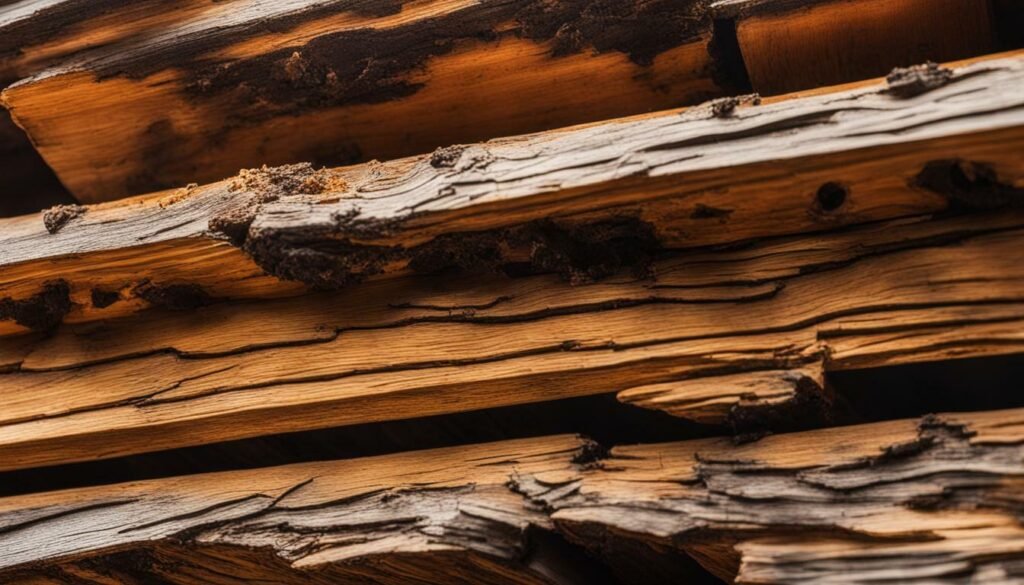Termite heat treatment is a popular method for eradicating termites, but it can potentially cause damage to your property if not properly executed. This method utilizes fans and heaters to circulate hot air throughout the structure, effectively killing the pests. It is especially useful for massive infestations and areas where chemicals cannot be used.
Heat treatment offers several advantages for termite control and extermination. Firstly, it is a chemical-free approach, making it a safe and eco-friendly option for homeowners. Additionally, it works quickly, providing fast-acting results in eliminating termite infestations. This method is particularly beneficial for homes located near bodies of water, as it does not pose a threat to aquatic life.
However, it is important to be aware of the potential risks and downsides associated with termite heat treatment. Controlled heat is crucial to ensure effective extermination, and proper preparation is necessary before undergoing the treatment. Hiring a licensed exterminator is highly recommended to prevent any damages or accidents from occurring during the process.
It is also worth noting that termite heat treatment is most effective for Drywood termites, but other termite species may require alternative methods for eradication. Therefore, it is essential to identify the specific termite species infesting your property before choosing a treatment approach.
Comparing termite heat treatment to fumigation, heat treatment offers unique benefits. Unlike fumigation, heat treatment is chemical-free and does not leave residual effects. It is also faster to complete, minimizing the inconvenience for homeowners. However, it is important to consider that heat treatment may be more expensive than fumigation and may have limited penetration ability.
Proper preparation plays a vital role in ensuring the success of termite heat treatment. Before the treatment, it is necessary to remove any items that can be damaged by excessive heat and ensure proper sealing of the house to prevent heat loss.
After the heat treatment, regular maintenance and prevention efforts are essential to maintain a termite-free environment. This includes regular inspections, maintenance of wooden structures, moisture control, and educating yourself about termite behavior and prevention methods.
Key Takeaways:
- Termite heat treatment is a popular method for termite control and extermination
- It is chemical-free, fast-acting, and suitable for homes near bodies of water
- Proper preparation and controlled heat are necessary for a successful treatment
- Heat treatment is most effective for Drywood termites
- Comparing to fumigation, heat treatment is eco-friendly and has faster completion time
Understanding termite heat treatment damage is crucial in protecting your property from these destructive pests. By taking proactive steps for termite control and extermination, you can ensure the long-term preservation of your home and avoid potential financial implications.
How Does Termite Heat Treatment Work?
Termite heat treatment involves the use of fans and heaters to raise the temperature inside your property, effectively killing termites in all areas. By heating the structure to a certain temperature, typically around 120-140 degrees Fahrenheit, the heat reaches all hidden areas where termites may be hiding. This method is particularly effective for eradicating Drywood termites, which are known to nest deep within the wood.
The process of termite heat treatment begins with a thorough inspection of the property to identify problem areas and determine the extent of the infestation. Once identified, fans and heaters are strategically placed throughout the structure to ensure even distribution of the heat. The temperature is then gradually increased and maintained at the desired level for a specific period of time, typically between 4-8 hours, to ensure complete eradication of all termites and their eggs.
One of the advantages of termite heat treatment is that it eliminates the need for the use of chemicals, making it a safe and eco-friendly option. It also offers fast-acting results, with termites usually being eradicated within a single treatment. Additionally, heat treatment is suitable for homes located near bodies of water where traditional chemical treatments may not be feasible or allowed.
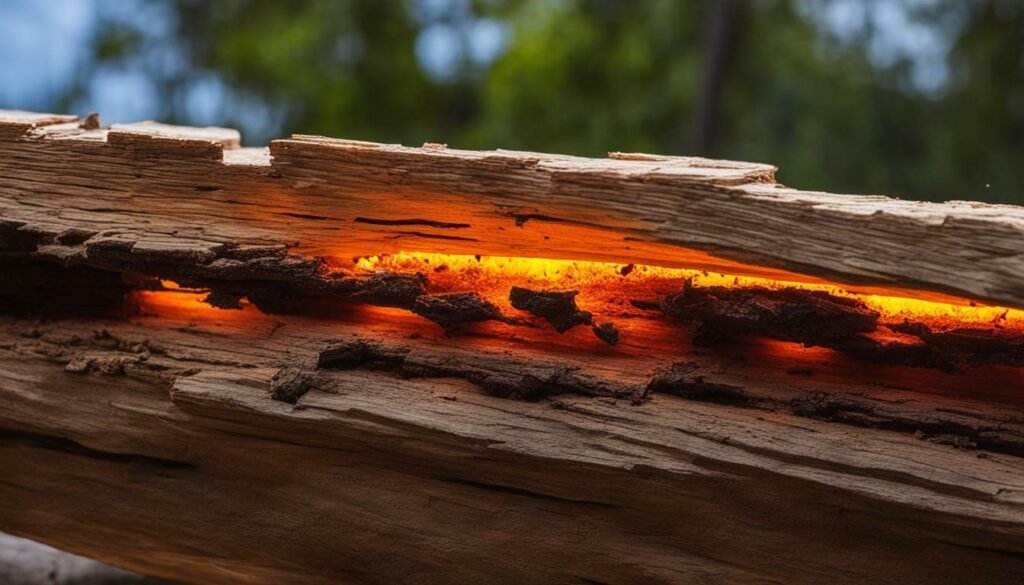

However, it is important to note that termite heat treatment does come with potential risks and downsides. The heat needs to be carefully controlled to prevent damage to the structure, and proper preparation is necessary prior to the treatment. It is strongly recommended to hire a licensed exterminator who is experienced in conducting heat treatments to ensure safety and effectiveness.
In summary, termite heat treatment is a highly effective method for eliminating termites from your property. By utilizing heat to reach all areas of infestation, it provides a chemical-free and fast-acting solution. While there are risks involved, proper preparation and the expertise of a professional exterminator can help ensure a successful treatment.
Advantages of Termite Heat Treatment
Termite heat treatment offers several advantages compared to other methods of termite extermination. One of the key benefits is that it is a chemical-free approach, making it a safer option for families and the environment. Chemical treatments can sometimes pose health risks and may require occupants to vacate the property temporarily. With heat treatment, there is no need for chemical sprays or toxins, providing peace of mind for homeowners.
Another advantage of heat treatment is its fast-acting nature. Termites are highly sensitive to heat, and exposure to high temperatures can quickly eliminate them. Heat treatment can achieve complete eradication within a single treatment, saving time and reducing the inconvenience of prolonged extermination processes.
Heat treatment is also especially suitable for homes located near bodies of water. Traditional termite extermination methods often involve the use of chemicals, which can be harmful to aquatic ecosystems. Heat treatment eliminates this concern, as it relies solely on the application of heat. This makes it an environmentally friendly option for homes situated close to lakes, rivers, or other bodies of water.
Benefits of Termite Heat Treatment at a Glance:
| Advantages | Description |
|---|---|
| Chemical-free | Safe for families and the environment |
| Fast-acting | Complete eradication in a single treatment |
| Suitable for homes near bodies of water | Environmentally friendly option |
When considering termite heat treatment, it is important to weigh its advantages against potential downsides and risks. While heat treatment can be highly effective, it requires proper control of heat levels and thorough preparation. Hiring a licensed and experienced exterminator is crucial to ensure the treatment is performed correctly and minimize the risk of damages or accidents.
Heat treatment is most effective for Drywood termites, which are commonly found in wooden structures. However, it may not be the most suitable method for other termite species. It is important to identify the specific termite species in an infestation to determine the appropriate treatment approach. Consulting with a professional exterminator will help determine the best course of action for effective termite eradication.


In comparison to fumigation, heat treatment offers several advantages. Unlike fumigation, heat treatment leaves no residual effects, eliminating the need for additional cleaning or ventilation post-treatment. Heat treatment is also known for faster completion times, minimizing the disruption to homeowners. However, it is worth noting that heat treatment can be more expensive than fumigation due to the specialized equipment and expertise required. Additionally, the penetration ability of heat treatment is limited, as it primarily targets termites in exposed areas. Deeper, hidden infestations may require alternative treatments.
To ensure a successful heat treatment, proper preparation is essential. Prior to the treatment, it is important to remove items that can be damaged by excessive heat, such as plants, artwork, or delicate furniture. Sealing the house is also necessary to prevent heat loss and maximize the effectiveness of the treatment. Following the heat treatment, regular inspections, maintenance of wooden structures, moisture control, and education about termite behavior and prevention are crucial for long-term termite control and prevention.
Risks and Downsides of Termite Heat Treatment
While termite heat treatment can be effective, there are some risks and downsides that should be considered before opting for this method. The controlled application of heat is crucial in order to ensure the complete eradication of termites without causing any harm to the structure of your home.
One of the main risks associated with heat treatment is the potential for damage to sensitive items within your home. Excessive heat can cause warping or melting of certain materials, such as electronics, artwork, or delicate furnishings. Before undergoing heat treatment, it is important to remove or protect these items to prevent any damage.
Another downside of heat treatment is the need for thorough preparation. In order for the treatment to be effective, the entire structure must be properly sealed to prevent heat loss. This can be a time-consuming and labor-intensive process, requiring meticulous attention to detail to ensure that all potential entry points are closed off.
To avoid these risks and downsides, it is highly recommended to hire a licensed exterminator who specializes in termite heat treatment. These professionals have the expertise and experience to perform the treatment safely and effectively, minimizing the risks of damage or accidents. They will also ensure that proper preparation is carried out and that the treatment is conducted in accordance with industry standards.
By being aware of the risks and downsides associated with termite heat treatment, and taking the necessary precautions, you can make an informed decision about the best course of action for termite extermination in your home.


Termite Species Suitable for Heat Treatment
Heat treatment is particularly effective for eliminating Drywood termites, but it may not be as effective for other termite species. Drywood termites infest and breed in dry wood, making them more vulnerable to high temperatures. The heat treatment process involves raising the temperature inside the infested structure to a level that exterminates the termites and their eggs.
While Drywood termites are the primary target for heat treatment, other termite species such as Subterranean termites and Formosan termites have different behaviors and habitats. These species typically nest in soil and construct mud tubes to travel between their nests and food sources. As a result, they are less likely to be affected by heat treatment alone. In such cases, alternative treatment methods, such as chemical treatment or baiting systems, may be more suitable.
To determine the most effective treatment approach for a termite infestation, it is crucial to identify the specific termite species involved. A professional termite inspector can perform a thorough assessment to identify the species and recommend the appropriate treatment method. Identifying the termite species accurately ensures targeted and effective elimination of the infestation, reducing the risk of further damage to your property.


Table: Comparison of Termite Species Suitable for Heat Treatment
| Termite Species | Suitability for Heat Treatment |
|---|---|
| Drywood Termites | Highly suitable |
| Subterranean Termites | Less suitable |
| Formosan Termites | Less suitable |
“Identifying the termite species accurately ensures targeted and effective elimination of the infestation.”
By understanding the termite species and their behavior, you can make informed decisions about the most appropriate treatment methods. While heat treatment is highly effective against Drywood termites, consulting with a professional is essential for accurate species identification and tailored extermination strategies.
Comparing Heat Treatment to Fumigation
When deciding between termite heat treatment and fumigation, it’s important to consider the differences between the two methods. Heat treatment, as discussed in the previous section, is a chemical-free approach that uses hot air to eliminate termites. Fumigation, on the other hand, involves the use of toxic gases to kill termites and other pests. While both methods can be effective, they have distinct advantages and limitations.
Heat Treatment
Heat treatment is eco-friendly, has no residual effect, and is faster to complete.
One of the main advantages of heat treatment is its eco-friendliness. Unlike fumigation, which relies on chemical pesticides, heat treatment does not leave behind any harmful residue. This makes it a safer option, particularly for homes with children, pets, or individuals with respiratory sensitivities. Additionally, heat treatment is known for its faster completion time. Depending on the size of the infestation, a heat treatment can be completed in as little as a few hours to a couple of days, compared to the several days required for fumigation.


However, it’s important to note that heat treatment may be more expensive than fumigation. The equipment required to heat a structure and the expertise needed to ensure proper execution can contribute to the higher cost. Additionally, heat treatment may have limited penetration ability compared to fumigation. For example, if a termite infestation extends to inaccessible areas within the structure, such as deep inside the walls or underground, heat treatment may not be as effective as fumigation in reaching and eliminating these hidden colonies.
Fumigation
Fumigation is effective for widespread termite infestations and can reach hidden colonies.
Contrary to heat treatment, fumigation is known for its ability to penetrate deep into the structure, making it effective for large-scale or widespread termite infestations. The gaseous pesticides used in fumigation have the capability to reach hidden colonies, ensuring comprehensive elimination of termites. However, it’s important to consider that fumigation involves the use of toxic chemicals, which may pose risks to human health and the environment.
In summary, both termite heat treatment and fumigation have their own advantages and limitations. Heat treatment is a chemical-free, fast-acting, and eco-friendly option, but it may be more expensive and have limited penetration ability. On the other hand, fumigation is effective for widespread infestations and can reach hidden colonies, but it involves the use of toxic pesticides. It’s recommended to consult with a licensed termite control professional to determine the most suitable treatment method based on the specific circumstances and extent of the termite infestation.
Preparation for Termite Heat Treatment
Proper preparation is crucial for a successful termite heat treatment. Before the treatment, there are a few important steps you need to take to ensure the effectiveness of the process. First, it is essential to remove any items that can be damaged by excessive heat, such as candles, aerosol cans, plastics, and electronics. These items can be stored in a safe place away from the treated area.
Next, you should seal the house to prevent heat loss during the treatment. Close all windows, doors, and vents tightly to create a controlled environment for the hot air to circulate. Inspect the structure for any cracks or gaps that may allow heat to escape and seal them with caulk or weatherstripping.
It is also recommended to remove any pets from the premises during the treatment to ensure their safety. The high temperatures involved in the process can be harmful to animals. Additionally, inform your neighbors about the upcoming termite heat treatment, as the process may release a noticeable amount of heat and noise.
| Preparation Checklist: |
|---|
| Remove items that can be damaged by excessive heat |
| Seal windows, doors, and vents tightly |
| Inspect and seal any cracks or gaps in the structure |
| Remove pets from the premises |
| Inform neighbors about the treatment |
Following these preparation guidelines will help ensure the success of your termite heat treatment. It is important to remember that heat treatment should only be performed by licensed professionals who have the knowledge and experience to handle the process safely and effectively.
Post-Treatment Maintenance and Prevention
After termite heat treatment, it is important to take preventive measures to maintain a termite-free environment. Regular inspections are crucial to identify any signs of termite activity and address them promptly. This can help prevent reinfestation and further damage to your property. Additionally, maintaining wooden structures is essential to minimize the risk of termite infestation. Keeping the wood dry and well-ventilated can deter termites from invading and nesting.
Moisture control is another vital aspect of termite prevention. Termites thrive in damp conditions, so fixing any leaks or moisture problems in your home is crucial. Ensure proper drainage around your property and repair any water leaks promptly. By addressing moisture issues, you can help create an environment that is less attractive to termites.
Educating yourself about termite behavior and prevention methods is also important in the post-treatment phase. By understanding how termites live, feed, and reproduce, you can implement effective preventive measures. This knowledge will enable you to make informed decisions about termite prevention techniques and choose the most suitable treatment methods for your property.
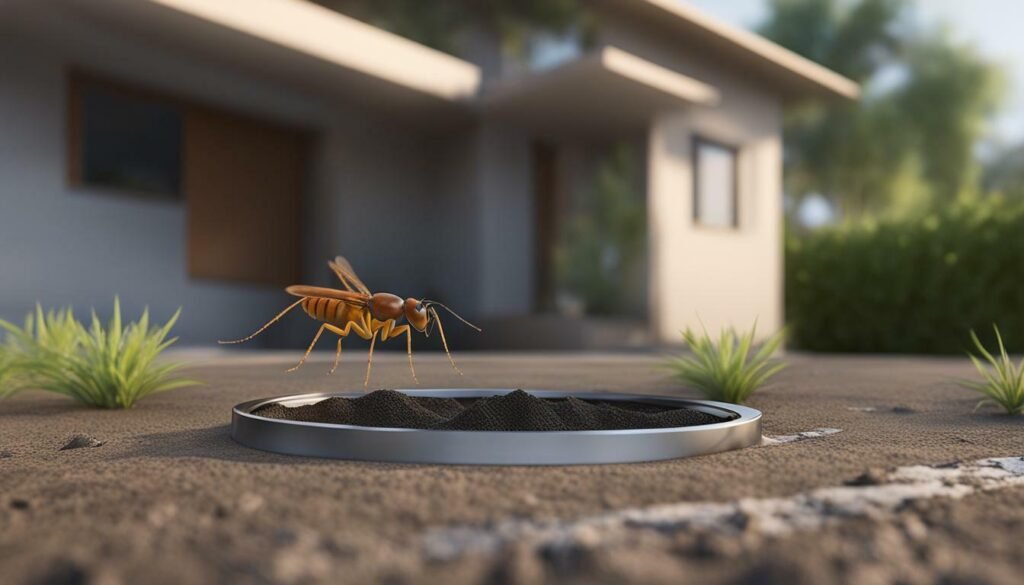

| Termite Prevention Tips: |
|---|
| 1. Conduct regular termite inspections to detect early signs of infestation. |
| 2. Maintain wooden structures by sealing any cracks or openings that may serve as entry points for termites. |
| 3. Keep your property well-ventilated and dry to deter termites from nesting. |
| 4. Remove any moisture sources, such as leaking pipes or standing water. |
| 5. Avoid storing firewood or lumber near your home, as it can attract termites. |
| 6. Trim trees and bushes, keeping them away from the structure to eliminate termite pathways. |
| 7. Educate yourself about termite behavior and prevention techniques to make informed decisions about termite control. |
“Prevention is always better than cure when it comes to termites. By implementing these preventive measures, you can safeguard your property and minimize the risk of termite infestation and damage.”
The Importance of Termite Control
Termite control is essential for protecting your property from the devastating damage caused by termite infestations. These tiny insects can wreak havoc on your home, feeding on the wooden structures and compromising their integrity. If left unchecked, termite infestations can lead to costly repairs and even structural collapse.
By implementing effective termite control measures, you can prevent the potential destruction of your property. Regular inspections by trained professionals can identify early signs of termite infestations, allowing for prompt treatment and mitigation efforts. Additionally, maintaining proper moisture control in and around your property can help deter termites, as they are attracted to damp environments.
Education about termite behavior and prevention is also crucial in maintaining a termite-free environment. Understanding the signs of a potential infestation, such as discarded wings, mud tubes, or hollow-sounding wood, can help you take timely action. By being proactive and implementing preventive measures, you can safeguard your property and minimize the risk of termite damage.
Table: Common Signs of Termite Infestation
| Sign | Description |
|---|---|
| Discarded Wings | After swarming, termites shed their wings, leaving them behind as evidence of a nearby infestation. |
| Mud Tubes | These tubes, made of mud and termite saliva, provide shelter and protection for termites as they travel between their nests and food sources. |
| Hollow-Sounding Wood | When termites feed on wood, they hollow it out from the inside, resulting in a hollow sound when tapped. |
Investing in professional termite extermination services is highly recommended for effective control and eradication. Trained professionals have the expertise and experience to identify termite species, locate infestation sources, and implement targeted treatment methods. They also have access to specialized tools and products that can eliminate termites efficiently.
Remember, termite control is not a one-time effort but an ongoing process. Regular inspections, maintenance of wooden structures, and proactive measures to reduce moisture levels in and around your property are essential for long-term protection. By taking these steps, you can ensure a termite-free environment and safeguard your property from the destructive impact of termite infestations.


Professional Termite Extermination Services
Hiring professional termite extermination services can ensure effective and long-lasting termite control. These experts have the knowledge, experience, and access to specialized treatment methods that are proven to eliminate termite infestations. By entrusting the task to professionals, you can have peace of mind knowing that your property is in capable hands.
Professional termite extermination services begin with a thorough inspection of your property to determine the extent of the infestation and identify the termite species involved. This information is crucial in determining the most appropriate treatment approach. Whether it’s heat treatment, fumigation, or other methods, the professionals will tailor the solution to meet the specific needs of your situation.
One of the key benefits of hiring professionals is their access to advanced technology and equipment. They are equipped with state-of-the-art tools that allow them to locate and target termite colonies, even in hard-to-reach areas. Additionally, they have a deep understanding of termite behavior and can implement strategies to prevent future infestations.
| Benefits of Professional Termite Extermination Services: |
|---|
| Expertise and experience in dealing with termite infestations |
| Access to specialized treatment methods |
| Thorough inspection and identification of termite species |
| Utilization of advanced technology and equipment |
| Implementation of preventive measures to avoid future infestations |
When it comes to termite control, it’s crucial to take swift action to minimize potential damage to your property. Hiring professional termite extermination services is an investment that pays off in the long run, as it ensures the complete eradication of termites and provides ongoing protection against future infestations. Don’t let termites threaten your home or business, trust the experts to safeguard your property from these destructive pests.
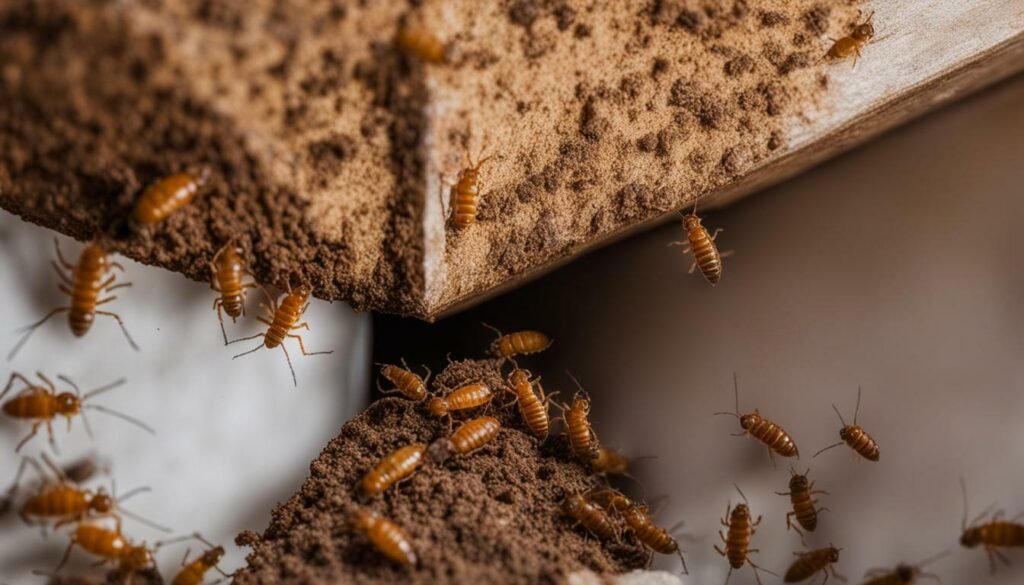

Termite Heat Treatment: A Worthwhile Investment
While termite heat treatment carries some risks, it is a worthwhile investment in safeguarding your property from termite damage. This method of extermination has gained popularity due to its effectiveness and advantages, making it a go-to solution for termite control.
One of the main advantages of termite heat treatment is that it is chemical-free. Unlike fumigation, which involves the use of potentially harmful chemicals, heat treatment relies on the power of hot air to eliminate termites. This makes it a safer option for your family and pets, as well as the environment.
Another significant benefit of heat treatment is its fast-acting nature. The high temperatures quickly penetrate deep into the structure, reaching areas where termites may be hidden. This ensures thorough extermination and minimizes the chances of reinfestation. Additionally, heat treatment is particularly suitable for homes near bodies of water, where chemical treatments may pose a risk to aquatic life.
| Advantages of Termite Heat Treatment |
|---|
| Chemical-free extermination |
| Fast-acting results |
| Suitable for homes near bodies of water |
However, it’s important to be aware of the risks involved in termite heat treatment. Proper heat control is crucial to prevent damage to your property, as excessive heat can warp wooden structures or cause other structural issues. This is why it’s essential to hire a licensed exterminator who understands the intricacies of heat treatment and can ensure its safe and effective implementation.
When considering termite heat treatment, it’s essential to identify the specific termite species infesting your property. While heat treatment is highly effective for Drywood termites, other species may require alternative methods to achieve full eradication. Proper identification will ensure that you choose the most suitable treatment approach for your specific situation.
In conclusion, termite heat treatment is a worthwhile investment in protecting your property from termite damage. It offers a chemical-free and fast solution for termite control, making it a safe and effective option. While it carries some risks, hiring a licensed exterminator and identifying the termite species will help mitigate these risks and ensure a successful treatment. With proper preparation and ongoing termite prevention efforts, you can enjoy a termite-free future and the peace of mind that comes with it.
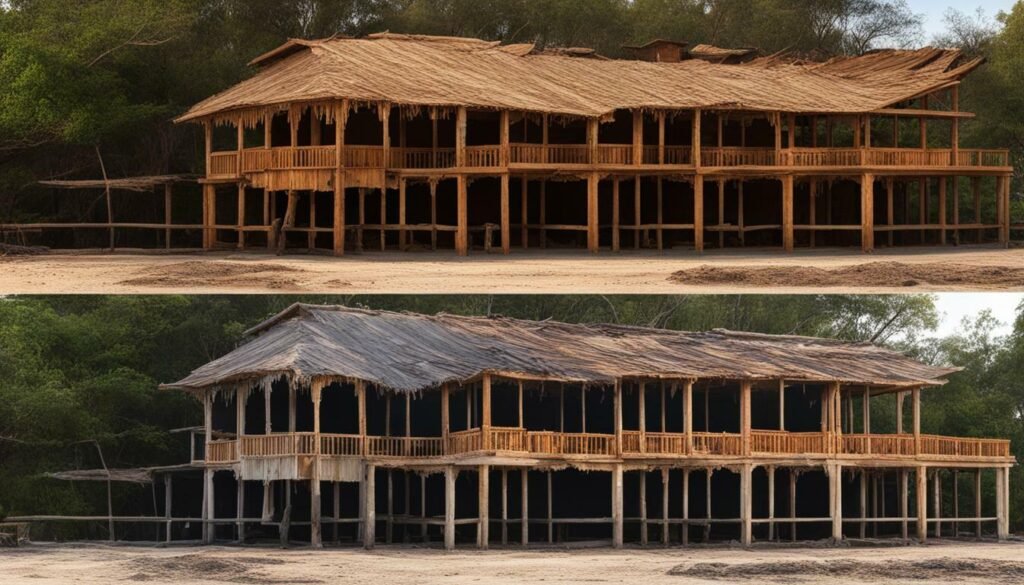

Conclusion
Understanding termite heat treatment damage is crucial for protecting your property and ensuring effective termite prevention and extermination. Heat treatment is a popular method for eradicating termites, using fans and heaters to circulate hot air throughout the structure and eliminate the pests. It is particularly effective for massive infestations and in areas where chemicals cannot be used.
One of the key advantages of heat treatment is its chemical-free nature, making it a safer option for your family and the environment. It also offers fast-acting results, quickly eliminating termites from your home. Additionally, heat treatment is suitable for homes near bodies of water, where traditional chemical treatments may pose a risk to aquatic life.
However, it is important to consider the potential risks and downsides of termite heat treatment. The heat needs to be carefully controlled during the process, and proper preparation is necessary to ensure the success of the treatment. To avoid damages and accidents, it is highly recommended to hire a licensed exterminator who has the expertise to handle the heat treatment safely and effectively.
While heat treatment is most effective for Drywood termites, it may not be suitable for all termite species. It is crucial to identify the specific termite species infesting your property before choosing a treatment approach. If heat treatment is not the right option, alternative methods may be required to eliminate the termites.
In comparison to fumigation, heat treatment has its own set of advantages. It is eco-friendly and leaves no residual effects, ensuring a safer environment for you and your family. The process is also faster, with heat treatment typically completing in less time compared to fumigation. However, it is important to note that heat treatment can be more expensive and its penetration ability may be limited.
Preparing your property for termite heat treatment is essential to maximize its effectiveness. This includes removing items that can be damaged by excessive heat and sealing the house to prevent heat loss. By following these guidelines, you can ensure that the heat treatment is successful in eliminating the termites from your home.
After the heat treatment, it is important to maintain proper post-treatment maintenance and prevention measures. Regular inspections, maintenance of wooden structures, moisture control, and educating yourself about termite behavior and prevention are key to ensuring a termite-free future. By taking these proactive steps, you can protect your property from termite damage and enjoy peace of mind.
Investing in professional termite extermination services is highly recommended to effectively control and prevent termite infestations. Professional exterminators have the expertise and experience to identify, treat, and eradicate termite infestations using the most effective methods available.
In conclusion, understanding termite heat treatment damage and its advantages and disadvantages is crucial for protecting your property. Despite the potential risks and downsides, heat treatment can be a worthwhile investment in preventing further termite damage, saving you both time and money in the long run. By taking proactive steps and utilizing professional services, you can ensure effective termite prevention and extermination, keeping your property safe and termite-free.
FAQ
Q: Is heat treatment effective for termite extermination?
A: Yes, heat treatment is a popular and effective method for eradicating termites, especially for massive infestations and in areas where chemicals cannot be used.
Q: What are the advantages of heat treatment for termite control?
A: Heat treatment is chemical-free, fast-acting, and suitable for homes near bodies of water. It also has no residual effect, making it an eco-friendly option.
Q: Are there any risks or downsides to heat treatment?
A: Yes, heat treatment requires controlled heat and proper preparation. It is recommended to have a licensed exterminator perform the treatment to avoid damages and accidents.
Q: Which termite species are suitable for heat treatment?
A: Heat treatment is most effective for Drywood termites, but other termite species may require alternative methods. It is important to identify the specific termite species before choosing a treatment approach.
Q: How does heat treatment compare to fumigation?
A: Heat treatment is eco-friendly, has no residual effect, and is faster to complete compared to fumigation. However, it may be more expensive and has a limited penetration ability.
Q: What preparation is necessary for termite heat treatment?
A: Proper preparation includes removing items that can be damaged by excessive heat and sealing the house to prevent heat loss.
Q: What steps should be taken after heat treatment for termite control?
A: After treatment, regular inspections, maintenance of wooden structures, moisture control, and education about termite behavior and prevention are necessary to ensure a termite-free future.
Q: Why is termite control important?
A: Termite control is essential to protect your property from the destructive nature of termite infestations and avoid potential financial implications.
Q: Should I hire professional termite extermination services?
A: Yes, professional termite extermination services provide expertise, experience, and access to effective treatment methods that can ensure thorough termite control.
Q: Is termite heat treatment a worthwhile investment?
A: Despite potential risks and downsides, termite heat treatment is a worthwhile investment in protecting your property from termite damage. It offers long-term cost savings and peace of mind.
Source Links
- https://ipm.ucanr.edu/PMG/PESTNOTES/pn7440.html
- https://pestsolutionshq.com/whole-house-heat-treatment-for-termites/
- https://www.termitefumigation.org/heat-treatment-for-termites/
Your Expert in Animal Control and Extermination. Trust our experience for humane, effective pest management, protecting your property and ensuring peace of mind with Michael S.

